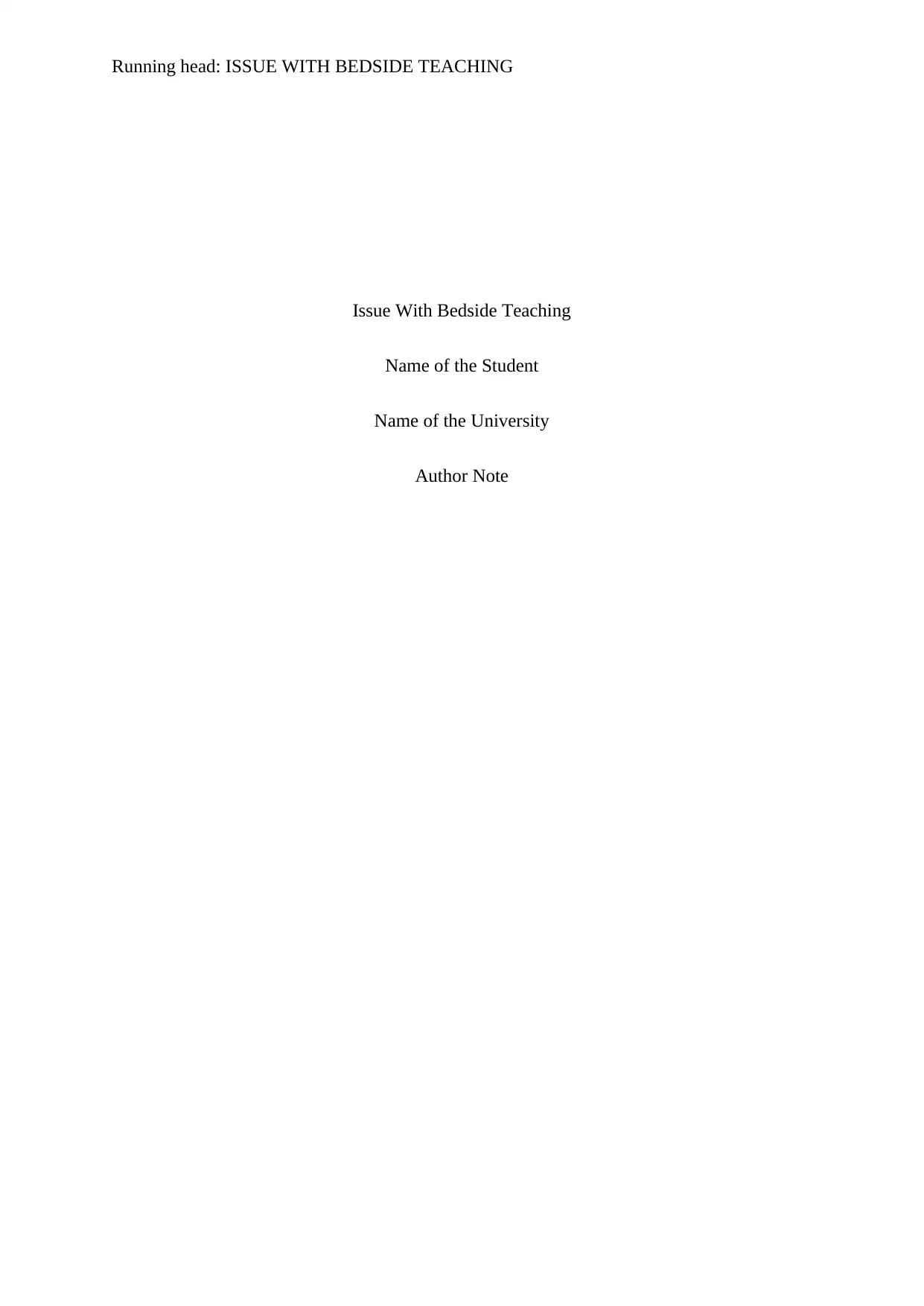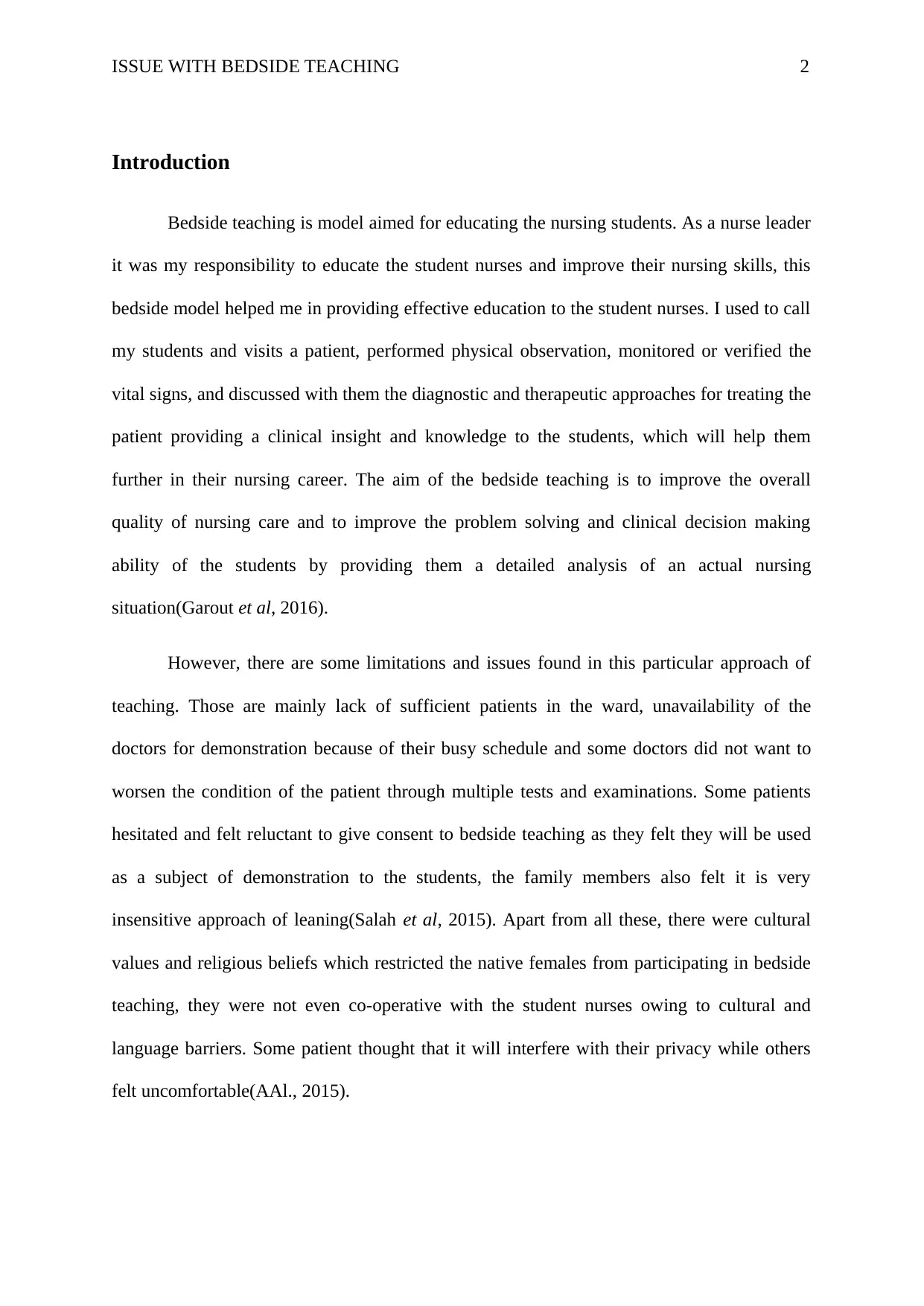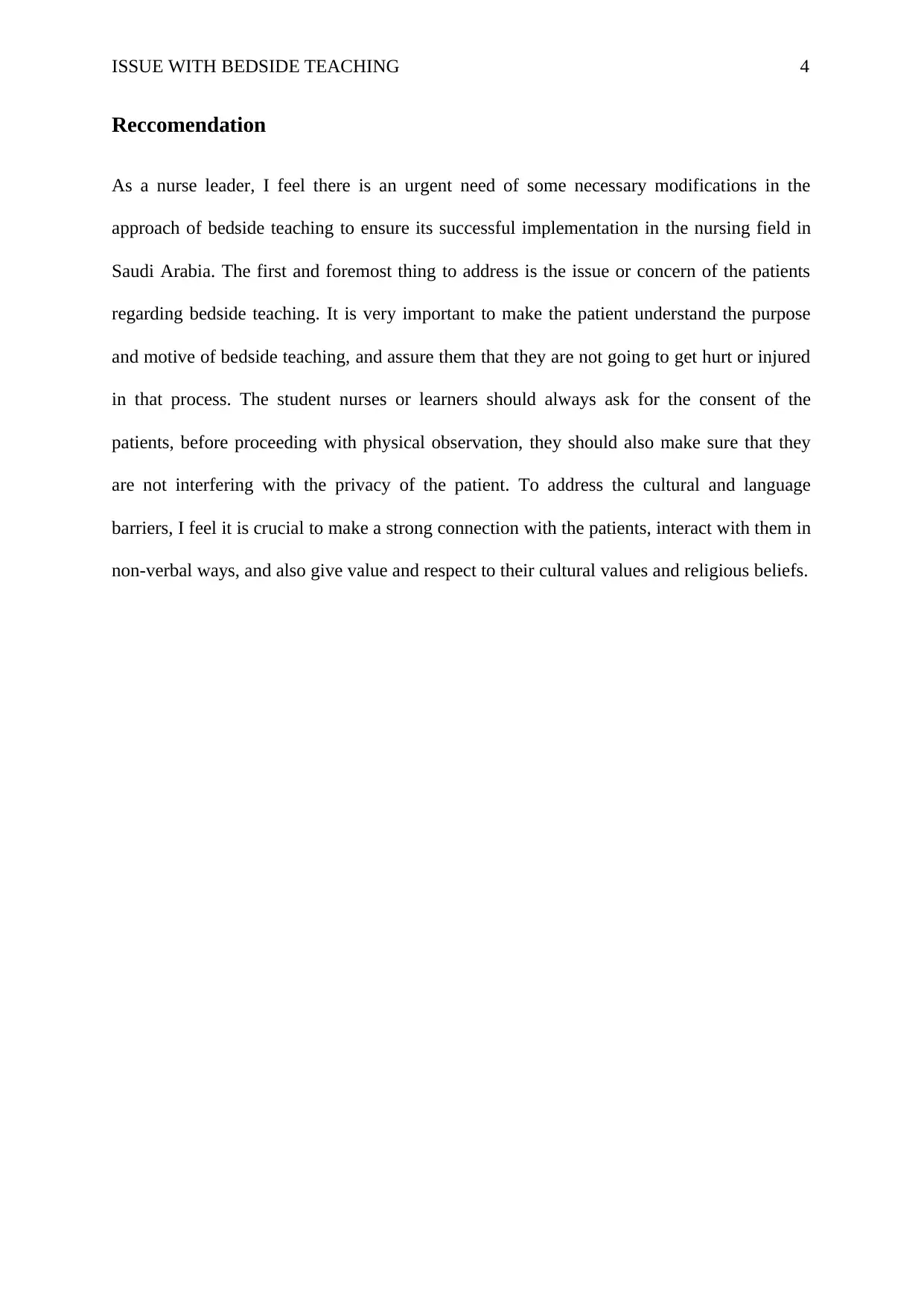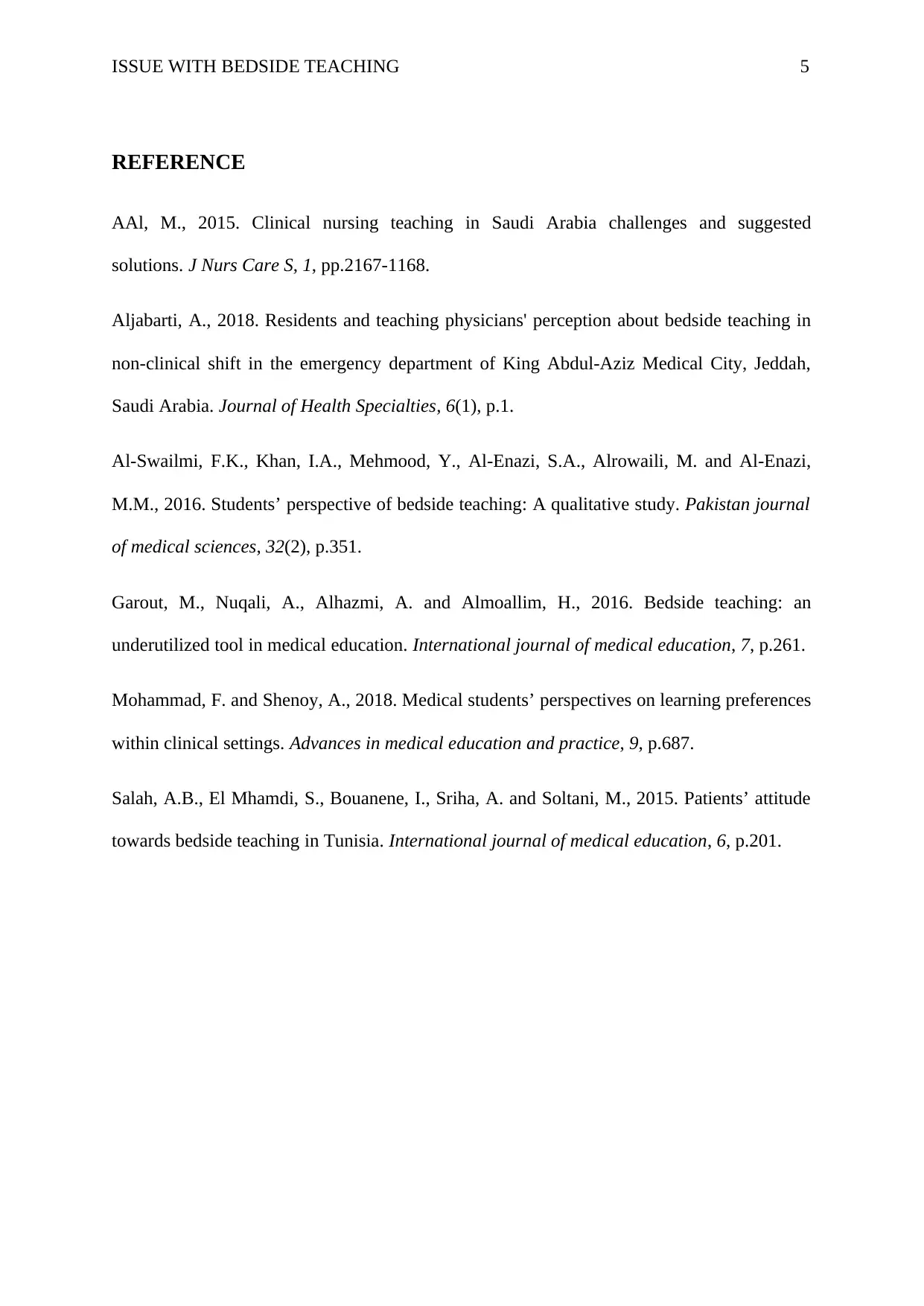Addressing Issues and Improving Bedside Teaching in Nursing
VerifiedAdded on 2022/09/15
|5
|1098
|18
Report
AI Summary
This report delves into the challenges associated with bedside teaching in nursing, focusing on the context of Saudi Arabia. It highlights issues such as a decline in bedside teaching practices, patient reluctance, cultural and religious barriers, and concerns about patient safety and privacy. The report critiques the impact of these issues on student nurses' clinical skill development and the overall quality of healthcare. It also explores the implications of decreased bedside teaching on the quality of patient care. The author recommends modifications to bedside teaching approaches, including addressing patient concerns, respecting cultural and language barriers, and ensuring patient consent and privacy. The report aims to provide insights into improving clinical education and patient care in nursing.

Running head: ISSUE WITH BEDSIDE TEACHING
Issue With Bedside Teaching
Name of the Student
Name of the University
Author Note
Issue With Bedside Teaching
Name of the Student
Name of the University
Author Note
Paraphrase This Document
Need a fresh take? Get an instant paraphrase of this document with our AI Paraphraser

ISSUE WITH BEDSIDE TEACHING 2
Introduction
Bedside teaching is model aimed for educating the nursing students. As a nurse leader
it was my responsibility to educate the student nurses and improve their nursing skills, this
bedside model helped me in providing effective education to the student nurses. I used to call
my students and visits a patient, performed physical observation, monitored or verified the
vital signs, and discussed with them the diagnostic and therapeutic approaches for treating the
patient providing a clinical insight and knowledge to the students, which will help them
further in their nursing career. The aim of the bedside teaching is to improve the overall
quality of nursing care and to improve the problem solving and clinical decision making
ability of the students by providing them a detailed analysis of an actual nursing
situation(Garout et al, 2016).
However, there are some limitations and issues found in this particular approach of
teaching. Those are mainly lack of sufficient patients in the ward, unavailability of the
doctors for demonstration because of their busy schedule and some doctors did not want to
worsen the condition of the patient through multiple tests and examinations. Some patients
hesitated and felt reluctant to give consent to bedside teaching as they felt they will be used
as a subject of demonstration to the students, the family members also felt it is very
insensitive approach of leaning(Salah et al, 2015). Apart from all these, there were cultural
values and religious beliefs which restricted the native females from participating in bedside
teaching, they were not even co-operative with the student nurses owing to cultural and
language barriers. Some patient thought that it will interfere with their privacy while others
felt uncomfortable(AAl., 2015).
Introduction
Bedside teaching is model aimed for educating the nursing students. As a nurse leader
it was my responsibility to educate the student nurses and improve their nursing skills, this
bedside model helped me in providing effective education to the student nurses. I used to call
my students and visits a patient, performed physical observation, monitored or verified the
vital signs, and discussed with them the diagnostic and therapeutic approaches for treating the
patient providing a clinical insight and knowledge to the students, which will help them
further in their nursing career. The aim of the bedside teaching is to improve the overall
quality of nursing care and to improve the problem solving and clinical decision making
ability of the students by providing them a detailed analysis of an actual nursing
situation(Garout et al, 2016).
However, there are some limitations and issues found in this particular approach of
teaching. Those are mainly lack of sufficient patients in the ward, unavailability of the
doctors for demonstration because of their busy schedule and some doctors did not want to
worsen the condition of the patient through multiple tests and examinations. Some patients
hesitated and felt reluctant to give consent to bedside teaching as they felt they will be used
as a subject of demonstration to the students, the family members also felt it is very
insensitive approach of leaning(Salah et al, 2015). Apart from all these, there were cultural
values and religious beliefs which restricted the native females from participating in bedside
teaching, they were not even co-operative with the student nurses owing to cultural and
language barriers. Some patient thought that it will interfere with their privacy while others
felt uncomfortable(AAl., 2015).

ISSUE WITH BEDSIDE TEACHING 3
According to the reports, it is found that the process of bedside teaching in Saudi
Arabia has faced a rapid downfall over the last few years, it declined form 72% in 1960s to
just 10-19% in the recent times. This has affected the overall clinical settings and reduced the
quality of health service as the trainees lacked proper skills and expertise to treat patients. It
was reported that only 45% of the learners were being esposed to bedside teaching and
gained adequate clinical knowledge and hands on experience about patient care, while the
others did not get any experience or training(Al-Swailmi et al, 20116).
Critique and Analysis
Though the issue with bedside teaching reduced the quality of health care and
deteriorated proper skill development of the student nurses and trainees, there were some
implications of the issue in the nursing field of Saudi Arabia, as it helped in ensuring patient
safety and security. The patient were no more at risk of being used as an experimental model.
The privacy and confidentialy issues that the patients reported were also resolved with the
decrease in bedside teaching. Along with the patient, the family members were also relieved
to know that the patient is safe and not being exposed to any further tests or clinical
examinations(Aljabarti, 2018).
Since the patient plays the key role in the bedside teaching, so if they are not willing
to participate or not giving consent to bedside teaching, then the doctors cannot pressurise or
manipulate them as that would be a violation in the law of informed consent. As a result, the
learners and trainees are devoid of proper clinical knowledge and hands on experience in
dealing with a real patient in an actual case. Also there is no skill development of the trainees
which later on affect their career and also reduces the quality of patient care due to minimum
clinical exposure and practical experience(Mohammad and Shenoy, 2018).
According to the reports, it is found that the process of bedside teaching in Saudi
Arabia has faced a rapid downfall over the last few years, it declined form 72% in 1960s to
just 10-19% in the recent times. This has affected the overall clinical settings and reduced the
quality of health service as the trainees lacked proper skills and expertise to treat patients. It
was reported that only 45% of the learners were being esposed to bedside teaching and
gained adequate clinical knowledge and hands on experience about patient care, while the
others did not get any experience or training(Al-Swailmi et al, 20116).
Critique and Analysis
Though the issue with bedside teaching reduced the quality of health care and
deteriorated proper skill development of the student nurses and trainees, there were some
implications of the issue in the nursing field of Saudi Arabia, as it helped in ensuring patient
safety and security. The patient were no more at risk of being used as an experimental model.
The privacy and confidentialy issues that the patients reported were also resolved with the
decrease in bedside teaching. Along with the patient, the family members were also relieved
to know that the patient is safe and not being exposed to any further tests or clinical
examinations(Aljabarti, 2018).
Since the patient plays the key role in the bedside teaching, so if they are not willing
to participate or not giving consent to bedside teaching, then the doctors cannot pressurise or
manipulate them as that would be a violation in the law of informed consent. As a result, the
learners and trainees are devoid of proper clinical knowledge and hands on experience in
dealing with a real patient in an actual case. Also there is no skill development of the trainees
which later on affect their career and also reduces the quality of patient care due to minimum
clinical exposure and practical experience(Mohammad and Shenoy, 2018).
⊘ This is a preview!⊘
Do you want full access?
Subscribe today to unlock all pages.

Trusted by 1+ million students worldwide

ISSUE WITH BEDSIDE TEACHING 4
Reccomendation
As a nurse leader, I feel there is an urgent need of some necessary modifications in the
approach of bedside teaching to ensure its successful implementation in the nursing field in
Saudi Arabia. The first and foremost thing to address is the issue or concern of the patients
regarding bedside teaching. It is very important to make the patient understand the purpose
and motive of bedside teaching, and assure them that they are not going to get hurt or injured
in that process. The student nurses or learners should always ask for the consent of the
patients, before proceeding with physical observation, they should also make sure that they
are not interfering with the privacy of the patient. To address the cultural and language
barriers, I feel it is crucial to make a strong connection with the patients, interact with them in
non-verbal ways, and also give value and respect to their cultural values and religious beliefs.
Reccomendation
As a nurse leader, I feel there is an urgent need of some necessary modifications in the
approach of bedside teaching to ensure its successful implementation in the nursing field in
Saudi Arabia. The first and foremost thing to address is the issue or concern of the patients
regarding bedside teaching. It is very important to make the patient understand the purpose
and motive of bedside teaching, and assure them that they are not going to get hurt or injured
in that process. The student nurses or learners should always ask for the consent of the
patients, before proceeding with physical observation, they should also make sure that they
are not interfering with the privacy of the patient. To address the cultural and language
barriers, I feel it is crucial to make a strong connection with the patients, interact with them in
non-verbal ways, and also give value and respect to their cultural values and religious beliefs.
Paraphrase This Document
Need a fresh take? Get an instant paraphrase of this document with our AI Paraphraser

ISSUE WITH BEDSIDE TEACHING 5
REFERENCE
AAl, M., 2015. Clinical nursing teaching in Saudi Arabia challenges and suggested
solutions. J Nurs Care S, 1, pp.2167-1168.
Aljabarti, A., 2018. Residents and teaching physicians' perception about bedside teaching in
non-clinical shift in the emergency department of King Abdul-Aziz Medical City, Jeddah,
Saudi Arabia. Journal of Health Specialties, 6(1), p.1.
Al-Swailmi, F.K., Khan, I.A., Mehmood, Y., Al-Enazi, S.A., Alrowaili, M. and Al-Enazi,
M.M., 2016. Students’ perspective of bedside teaching: A qualitative study. Pakistan journal
of medical sciences, 32(2), p.351.
Garout, M., Nuqali, A., Alhazmi, A. and Almoallim, H., 2016. Bedside teaching: an
underutilized tool in medical education. International journal of medical education, 7, p.261.
Mohammad, F. and Shenoy, A., 2018. Medical students’ perspectives on learning preferences
within clinical settings. Advances in medical education and practice, 9, p.687.
Salah, A.B., El Mhamdi, S., Bouanene, I., Sriha, A. and Soltani, M., 2015. Patients’ attitude
towards bedside teaching in Tunisia. International journal of medical education, 6, p.201.
REFERENCE
AAl, M., 2015. Clinical nursing teaching in Saudi Arabia challenges and suggested
solutions. J Nurs Care S, 1, pp.2167-1168.
Aljabarti, A., 2018. Residents and teaching physicians' perception about bedside teaching in
non-clinical shift in the emergency department of King Abdul-Aziz Medical City, Jeddah,
Saudi Arabia. Journal of Health Specialties, 6(1), p.1.
Al-Swailmi, F.K., Khan, I.A., Mehmood, Y., Al-Enazi, S.A., Alrowaili, M. and Al-Enazi,
M.M., 2016. Students’ perspective of bedside teaching: A qualitative study. Pakistan journal
of medical sciences, 32(2), p.351.
Garout, M., Nuqali, A., Alhazmi, A. and Almoallim, H., 2016. Bedside teaching: an
underutilized tool in medical education. International journal of medical education, 7, p.261.
Mohammad, F. and Shenoy, A., 2018. Medical students’ perspectives on learning preferences
within clinical settings. Advances in medical education and practice, 9, p.687.
Salah, A.B., El Mhamdi, S., Bouanene, I., Sriha, A. and Soltani, M., 2015. Patients’ attitude
towards bedside teaching in Tunisia. International journal of medical education, 6, p.201.
1 out of 5
Related Documents
Your All-in-One AI-Powered Toolkit for Academic Success.
+13062052269
info@desklib.com
Available 24*7 on WhatsApp / Email
![[object Object]](/_next/static/media/star-bottom.7253800d.svg)
Unlock your academic potential
Copyright © 2020–2025 A2Z Services. All Rights Reserved. Developed and managed by ZUCOL.





